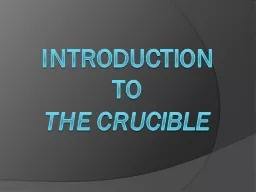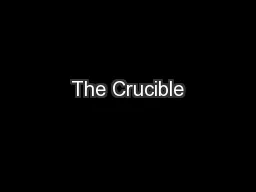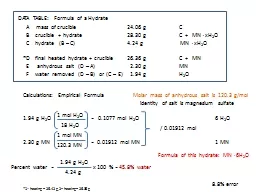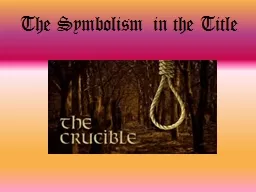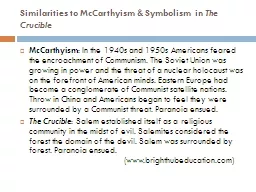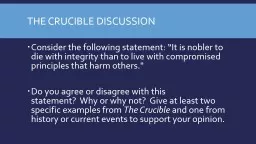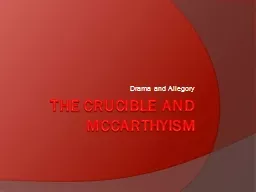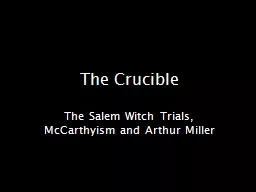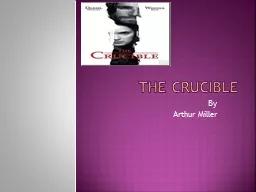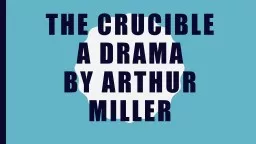PPT-Introduction to The Crucible
Author : karlyn-bohler | Published Date : 2019-11-23
Introduction to The Crucible The Crucible is Puritanism Witchcraft McCarthyism Arthur Miller Puritanism Christian faith that originated in England during the
Presentation Embed Code
Download Presentation
Download Presentation The PPT/PDF document "Introduction to The Crucible" is the property of its rightful owner. Permission is granted to download and print the materials on this website for personal, non-commercial use only, and to display it on your personal computer provided you do not modify the materials and that you retain all copyright notices contained in the materials. By downloading content from our website, you accept the terms of this agreement.
Introduction to The Crucible: Transcript
Introduction to The Crucible The Crucible is Puritanism Witchcraft McCarthyism Arthur Miller Puritanism Christian faith that originated in England during the early 1600s They were a religious. Characters. Literary Terms. Plot Events. Setting. Quote. Significance. 100. 100. 100. 100. 100. 200. 200. 200. 200. 200. 300. 300. 300. 300. 300. 400. 400. 400. 400. 400. 500. 500. 500. 500. 500. Who is the . By Arthur Miller. Arthur Miller 1915-2005. Father was successful business owner, but lost everything during the great depression.. Depression . had a . profound impact . on the development of his social consciousness. . B crucible + hydrate 28.30 g C + MN . .. xH. 2. O. C hydrate (B – C) 4.24 g . MN . .. xH. 2. O. *D final heated hydrate + crucible 26.36 g C + MN. E anhydrous salt (D – A) 2.30 g MN. What is a Crucible?. A container that can withstand very high temperatures and is used for metal, glass, and pigment production as well as a number of modern laboratory processes. . A Crucible as a Scientific Tool. Finding the Simplest Formula. Finding the Simplest Formula. Imagine you react 2.6512 g of Zn is reacted with excess Cl. 2(g). When the Zn and Cl. 2. have finished reacting a white powder is left and has a mass of 5.4512 g. crucible. The 12 week boot camp required recruits to wake up at 4 a.m., run 8 miles a day, and live on only dried apricots and beef jerky. It was a . crucible. where they were tested both physically and mentally, but they knew that this training was the only hope of surviving the zombie hordes that drew closer every day.. Vocabulary Chart. Start a vocabulary chart for . The Crucible. Word and Part of Speech. Definition. Phrase or Sketch. to help you remember. Use in. a sentence.. theocracy (n). p. 1101. a. government ruled by religious authority. to . McCarthyism. & . Symbolism . in . The Crucible . McCarthyism. : In the 1940s and 1950s Americans feared the encroachment of Communism. The Soviet Union was growing in power and the threat of a nuclear holocaust was on the forefront of American minds. Eastern Europe had become a conglomerate of Communist satellite nations. Throw in China and Americans began to feel they were surrounded by a Communist threat. Paranoia ensued.. Consider the following statement: “It is nobler to die with integrity than to live with compromised principles that harm others." . Do . you agree or disagree with this statement? Why or why not? Give . The Crucible. Act 4. Quotations. More Quotes. Literary. Devices. The Crucible. 200. 200. 200. 200. 200. 400. 400. 400. 400. 400. 600. 600. 600. 600. 600. 800. 800. 800. 800. 800. 1000. 1000. 1000. 1000. . Drama and Allegory. The Rise of Communism. First Red Scare – 1917-1920. Russian Revolution - 1919. People accused/jailed with little or no evidence . 1939 WWII – Russia, ally to USA. Alien Registration Act – 1940 . Who Really Moves the . Ouija . Board?. The devil gives people powers. The devil grants loyalty if those with the “powers” harm others. Historical Context. A "witchcraft craze" rippled through Europe from the 1300s to the end of the 1600s. . Setting. Salem, Massachusetts, 1692.. Point of View. The narrator actually inserts himself into the play several times to describe characters and tell us what we should think about them, such as when he tells us that Judge Hathorne is a bitter man. In addition, each inserted stage direction indicates exactly what a character is thinking or feeling. The narrator is able to jump into any character’s mind at any given moment. Elements of a drama. Acts and scenes. There are USUALLY 4 acts in a play. Each act has multiple scenes within it. Dialogue. Conversation among people. In a play there will be no quotation marks. Mostly everything is dialogue so it’ll just have the character’s name and then their line.
Download Document
Here is the link to download the presentation.
"Introduction to The Crucible"The content belongs to its owner. You may download and print it for personal use, without modification, and keep all copyright notices. By downloading, you agree to these terms.
Related Documents

